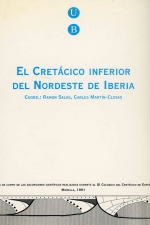Добрый день, Коллеги. Важное сообщение, просьба принять участие. Музей Ферсмана ищет помощь для реставрационных работ в помещении. Подробности по ссылке
El cretacico inferior del Nordeste de Iberia
On the occasion of the III Colloquium on the Cretaceous of Spain, which took place in More-lla on the 6th, 7th and 8th September 1991 sponsored by the Spanish Group of Mesozoic, there were two field trips to illústrate the present knowledge of the Lower Cretaceous of Northeastern Iberia. These excursions are the object of the present guide-book. In the period passed between when this guide-book was written and its final publication, new results were published which represent a significant increase in our previous knowledge. These publications in international journals, which are referenced at the end of the foreword, together with the figure captions of this guide-book, which have been translated in English, will help the English reader to obtain the information necessary to understand the Lower Cretaceous of Northeastern Iberia.
The precongress excursión was in the Organyá Basin (Central Pyrenees) whereas the postcon-gress excursión took place in the Maestrat and Aliaga-Penyagolosa Basins, which are located at the Southeastern end of the Iberian Ranges.
Studies on the Lower Cretaceous of Northeastern Iberia indícate that the evolution of basins mainly occurred during a generalized stage of rifting, which lasted from the Late Hauterivian until the Middle Albian (Berástegui et al., 1990; Salas & Casas, 1993).
The Early Cretaceous rift stage was preceded by a Neocomian (Late Valanginian to Late Hauterivian) postrift stage, or modérate rift stage, related to the thermal relaxation of the lithosphere, which was subsequent to the main Late Jurassic rift period. However, in the most subsident areas of particular basins, such as the Maestrat basin, the extensional deformation was almost continuous throughout the Early Cretaceous and this resulted in a long rift, lasting from Upper Jurassic to Middle Albian with only a short Hauterivian postrift interval (Salas & Casas, 1993).
During rift stages extensional structures developed and controlled the depositional sequences and their depositional systems. Some of these structures were later inverted during the Neogene compressive stages, but are still identifiable in the field (Berástegui et al., 1990). In particular sectors of the Maestrat, Aliaga-Penyagolosa and Orpesa Basins, inversión was limited enough to allow unique outcrops to be preserved. (Roca et al., 1994).
We noticed strong parallelisms between sedimentation, stratigraphic discontinuities and extensional tectonics of Northeastern Iberian basins (Salas & Casas, 1993), the Atlantic margin basins (Tankard & Balkwill, 1989) and the Central South-Pyrenean basins ( Berástegui et al., 1990). The opening of the Neotethys towards the West produced a particular evolution of Iberian intraplate basins. Firstly, a rift phase is recorded lasting from the Late Permian to the Early Jurassic. A postrift stage followed during the Early and Middle Jurassic. Later on, the Late Jurassic to Early Cretaceous rift stage, which is the object of the present guide book, was related to the Central Atlantic opening.




